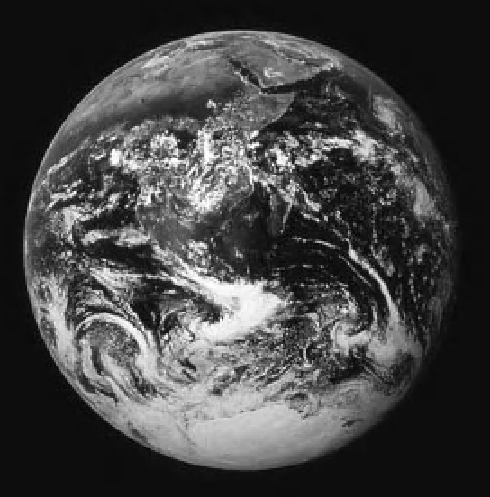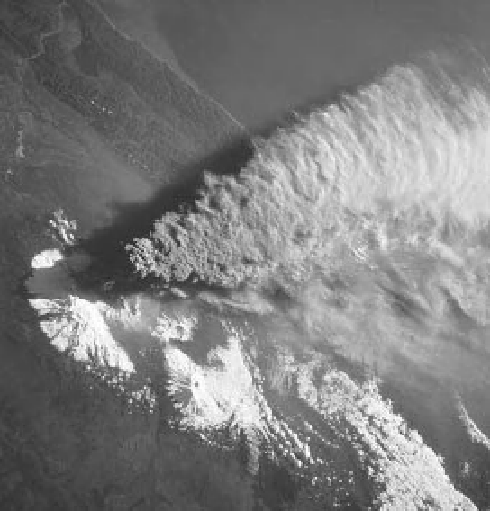Geoscience Reference
In-Depth Information
Figure 8-20.
The whole Earth photographed during
the Apollo 17 mission showing Africa, Arabia, and
Antarctica (see Color Plate 8-20). Clouds, ice, and
deserts have high albedo; oceans and land vegetation
have low albedo. Image courtesy of K. Lulla, NASA
Johnson Space Center. Photo ID: AS17-148-22727,
December 1972.
Figure 8-21.
Eruption of Mt. Kliuchevskoi volcano
(snow covered) on the Kamchatka Peninsula of Russia.
Ash plume drifted toward the southeast over the Pacii c.
The 1991 eruption of Mt. Pinatubo in the Philippines
created a signii cant ash effect that is credited with
measurable climatic cooling during 1992-93. Image
courtesy of K. Lulla, NASA Johnson Space Center. Photo
ID: STS68-150-045, September 1994.
of years. Just as sea level rose and fell during
several glacial cycles of the past one million
years, so the Earth's climate experienced large
oscillations from glacial to interglacial condi-
tions. Several factors play primary roles within
the climatic system.
albedo
-
water bodies and vegetation
-
has
the opposite effect.
• Oceanic circulation - oceans, atmosphere
and ice sheets are coupled in terms of
the distribution of heat around the world.
Oceanic currents move heat and salt in a
thermohaline circulation system.
• Solar energy - may vary in the quantity or
quality (spectrum) of radiation, and oscilla-
tions in earth/sun orbital geometry affect the
seasonal and latitudinal distribution of sun-
light received on Earth.
• Greenhouse gases - carbon dioxide, methane,
water vapor, and ozone absorb thermal-
infrared radiation emitted from the Earth's
surface, thus warming the lower atmosphere.
• Albedo - refers to the rel ectivity of the
Earth's surface and atmosphere (Figs. 8-20
and 8-21). Increased albedo
-
clouds, vol-
canic dust, snow, ice, deserts
-
causes more
incoming radiation to rel ect back into
space, thus having a cooling effect. Decreased
The Sun is the source of all energy that drives
the Earth's climatic system; solar energy is the
ultimate control of climate. The 11-year cycle of
sunspots is so well known to astronomers and
the public alike that it is usually considered to
be a permanent i xture of solar activity. However,
the sunspot cycle is variable in length and
strength. For example, the most recent sunspot
cycle (23) reached a peak in 2000, which was
comparable to cycles of the late twentieth
century. However, the decline to the low ebb of
the cycle extended until 2008-09, and a new
cycle (24) began late in 2009, about four years






